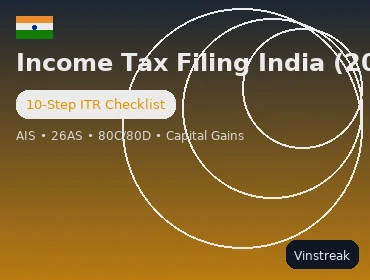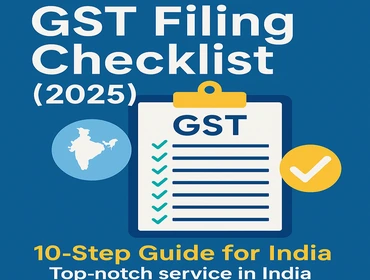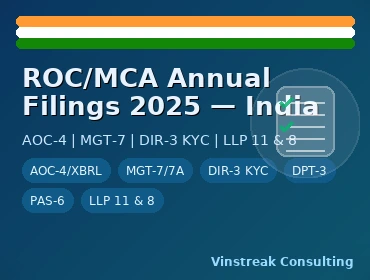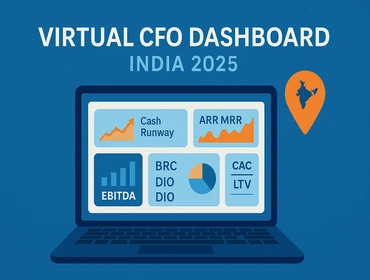
Income Tax Filing India (2025): A 10-Step ITR Checklist
The Income tax filing India 2025 matters because missed disclosures and incorrect forms trigger notices and delays in refunds. Use this practical guide to file ITR-1/2/3/4 accurately, reconcile AIS & Form 26AS, optimize old vs new regime, and capture 80C/80D/HRA deductions. Need expert help? Our IT Return Filing and Virtual CFO teams deliver Top income tax return filing services — widely regarded as the Best income tax consultants in India.
1) Choose the correct ITR form & tax regime
Map income sources to ITR forms: ITR-1 (salaried/simple), ITR-2 (capital gains/multiple properties), ITR-3 (business/profession), ITR-4 (presumptive 44AD/44ADA/44AE). Compare old vs new regime using slab rates for AY 2025-26 and pick the lower tax.
- Residential status & reporting of foreign assets where applicable.
- New regime default vs opting for old regime — compute both.
- Keep declaration/workings for regime selection in your workpapers.
2) Gather proofs: Form 16, interest, rent & investments
Collate Form 16, salary slips, bank interest certificates, rent receipts, home loan interest, ELSS/PPF/NSC, medical insurance (80D), donations (80G), and education loan interest (80E).
- Broker statements for equity/ MF; registrar statements for dividends.
- Rental agreements, municipal tax receipts & co-owner ratios.
- Keep PAN/Aadhaar and bank validation ready for refund.
3) Reconcile AIS, TIS & Form 26AS
Match AIS/TIS and 26AS with your books and proofs. Resolve mismatches in TDS/TCS, interest, securities transactions, and property deals to avoid 139(9) defective return or under-reporting flags.
- Categorize: fully matched, partially matched, missing, wrong PAN credit.
- Seek deductor corrections; add voluntary disclosures with notes.
- Preserve CSV/PDF downloads as audit trail.
4) Salary, house property & other income
Fill salary schedules, house property (HRA, interest, co-ownership), and other income (savings/FD interest, dividends, gifts). Apply HRA exemption or section 24(b) interest as eligible.
- Standard deduction and professional tax (old regime where applicable).
- Pre-construction interest apportionment for housing loans.
- Clubbing provisions for minor income and specified assets.
5) Capital gains: equity, debt, real estate & digital assets
Compute short/long-term capital gains with appropriate acquisition rules and indexation where allowed. Capture STT, grandfathering (where applicable historically), and broker-wise statements.
- Set-off & carry-forward of losses with past ITR references.
- Property: stamp duty value checks, cost of improvement, brokerage.
- Digital/virtual assets: follow current disclosure and TDS rules.
6) Business/Profession & presumptive (44AD/44ADA/44AE)
Choose between regular books vs presumptive taxation for small businesses and professionals. Evaluate 44AB audit applicability. Maintain expense evidence and GST/TDS alignment.
- Cash vs digital turnover split where relevant for presumptive rates.
- Partner remuneration/interest rules for firms.
- Reconcile with GST returns to avoid cross-tax mismatches.
7) Deductions & exemptions (80C/80D/80G/HRA/LTA etc.)
Optimize 80C (ELSS/PPF/EPF/SSY), 80D (health insurance), 80G (donations), 80E (education loan), and applicable exemptions (HRA/LTA) under the old regime. Check new regime eligibility rules before claiming.
- Verify receipts & payment modes (cash limits where prescribed).
- Dependent parents’ 80D and preventive health check-up limits.
- Donation eligibility & 80G receipt details captured.
8) Advance tax, self-assessment & TDS/TCS compliance
Review advance tax payments, compute self-assessment tax, and ensure TDS/TCS credits are correctly reflected. Generate challans and document ITR-V/ARN references.
- Forecast tax from capital gains/business mid-year to avoid interest.
- TDS returns (24Q/26Q) for deductors; vendor PAN compliance.
- Foreign remittance: Form 15CA/15CB workflow where applicable.
9) E-file, e-verify, refund tracking & rectification
Submit ITR on the portal, then e-verify via Aadhaar OTP, bank demat EVC, or DSC. Track refund status and handle u/s 154 rectification or 139(9) if any defect notice is issued.
- Verify within timelines to avoid return becoming invalid.
- Maintain acknowledgment, XML/JSON, and working papers.
- PAN–Aadhaar link & bank pre-validation checks.
10) Dashboards, notices & audit readiness
Build a founder/CFO dashboard: regime comparison, deduction utilization, AIS gaps, refund ETA, and notice tracker. Keep a notice response SOP and 44AB audit checklist ready.
- Variance alerts vs last year and salary structure changes.
- Capital gains summary by broker/folio; loss carry-forward map.
- Auto-export board-ready PDF pack.
Common mistakes to avoid (and quick fixes)
- Filing wrong ITR form — Fix: map income sources to ITR-1/2/3/4.
- Skipping AIS/26AS match — Fix: reconcile and add notes/disputes.
- Ignoring capital gains statement — Fix: import broker data & verify ISINs.
- Missing e-verification — Fix: e-verify immediately; track status.
- Not comparing regimes — Fix: compute old vs new and document choice.





